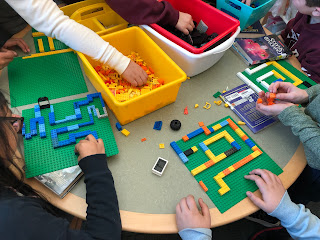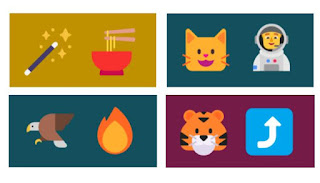Our Community Read
Every year our community participates in a town read. Books are chosen with incredible attention paid to the ENTIRE community. There is always an adult choice as well as a related YA and young reader choice. This year the adults are reading How To Be a Good Creature by Sy Montgomery while our youngest readers are reading Inky's Amazing Escape. Here is our school's journey:
The activity:
Inky was curious. What are you curious about? Explore our database and report about
My takeaways: This book was a perfect segue into research topics! This led us to an activity where we practiced identifying keywords and we used the game Search Shark to reinforce the concepts. Now 3rd graders are ready to do their own research!
2nd Grade
I asked 2nd graders to create an animal they are curious about. Their creation choices:
My takeaways: Being that we had recently created origami bookmarks for our Kindergarten friends, some of these students already had the skills to create a great base for an animal. This was very convenient! Creating with pipe cleaners was a popular choice because of the newness of the activity.
1st Grade
I attempted the 2nd-grade plan, but there were WAY too many choices and this didn't go well for my first class so I scaled it back. I ended up having them simply draw. I pulled a large stack of animal books for them to peruse and we went from there. This was much more doable and successful.
1st & 2nd Grade
The last piece of our journey was to take the animals we created and think creatively about them. I read Q is for Duck by Mary Elting as inspiration and we created our own ABC books.
These did NOT include every letter of the alphabet. In fact, some books had 4 pages of the same letter. I was more interested in creativity than inclusivity. We also made a cover for our book based on the most appropriate descriptor for the class. Once the books were completed, we read them.
My takeaways: There was less "making" involved in the 1st-grade version of the project, but it allowed us to focus on the creativity piece which was more important to me.
This experience helped us to be part of our larger community. I am so grateful that the community read extends down to our youngest learners!
Day 1
We began class by watching a video of an octopus escaping from a boat to set the scene (thank you Sarah Bickel)!:
Students watched the video and "ooh-ed," and "ew-ed" their way through it. Now I had their attention! We segued into our book which shares the true story of Inky the Octopus's escape from the New Zealand Aquarium.
Things that caught my students' attention:
- Octopus are hatched from an egg the size of a grain of rice.
- They are independent immediately after birth.
- Inky liked to play with legos and Mr. Potato Head.
- Inky could fit in a drain and navigate all the way to the ocean.
Day 2
We began with another video showcasing the octopus's ability to camouflage itself. Again, more "oohs" and "woahs" got us started.
Today's class was intended to extend our thinking. From here the different grades had different experiences.
4th and 5th graders were challenged to create a "playground" for an octopus. (I had to explain that the word "playground" was being used loosely here after the first swing was created). We knew that Inky was very curious and loved to explore. Students were challenged to create something that an octopus would love to explore - the more nooks and crannies, the better. Choices for creating a maze:
- Draw (using graph paper)
- Use Strawbees
- Build with Legos
- Create with Keva planks
- Use Makedo tools and cardboard
*All materials used here were generously donated by the Dedham Library Innovation Team over the last five years.
 |
| Graph paper & rulers were all we needed to make mazes. |
 |
| Strawbees proved to be the most challenging medium for builders. |
 |
| This team used Keva planks AND Strawbees! |
 |
| Legos were by far the most popular choice. |
 |
| Makedo tools are new to our library. A stack of boxes provided hours of fun! |
My takeaways: I would find large groups of students flocking to one kind of activity, but it varied class to class. There was no predicting what would capture the attention of the specific group. This was great fun to watch!
3rd Grade
I used this opportunity to explore our databases with the 3rd graders who haven't done so yet. The timing was perfect, as this group will soon be conducting research in their classrooms.The activity:
Inky was curious. What are you curious about? Explore our database and report about
- 1 thing I learned
- 1 question I have
2nd Grade
I asked 2nd graders to create an animal they are curious about. Their creation choices:
- Draw
- Fold (I provided origami books for this table)
- Build
- Legos
- Pipe cleaners
When students were done they wrote their names on "creation cards" to display with their projects. I got wrapped up with the project and never took a picture of the giant shelf that housed our many creations! Here are some of the creations:
 |
| Chick |
 |
| Octopus |
 |
| Tiger |
 |
| Giraffe |
My takeaways: Being that we had recently created origami bookmarks for our Kindergarten friends, some of these students already had the skills to create a great base for an animal. This was very convenient! Creating with pipe cleaners was a popular choice because of the newness of the activity.
1st Grade
I attempted the 2nd-grade plan, but there were WAY too many choices and this didn't go well for my first class so I scaled it back. I ended up having them simply draw. I pulled a large stack of animal books for them to peruse and we went from there. This was much more doable and successful.
1st & 2nd Grade
The last piece of our journey was to take the animals we created and think creatively about them. I read Q is for Duck by Mary Elting as inspiration and we created our own ABC books.
These did NOT include every letter of the alphabet. In fact, some books had 4 pages of the same letter. I was more interested in creativity than inclusivity. We also made a cover for our book based on the most appropriate descriptor for the class. Once the books were completed, we read them.
 |
| Yes, even unicorns entered our animal book! |
This experience helped us to be part of our larger community. I am so grateful that the community read extends down to our youngest learners!













This is terrific. As a representative of DLIT - the sponsoring organization for the Community Read, we are all thrilled that the public schools engage so fully in the program.
ReplyDeleteWe CAN engage so fully in the program because of your thoughtful decision making in choosing books and themes that can include ALL readers. Thank you for your leadership, knowledge, and inclusive choices!
Delete